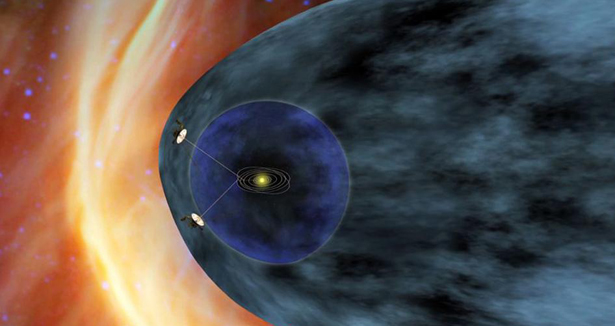Get Ready, Because Voyager I Is *This Close* to Leaving Our Solar System
We're on the cusp of one of the greatest scientific accomplishments of all time, but we may not know when the moment strikes. Or, rather, there may be no moment.

Last week, in the corners of the Internet devoted to outer space, things started to get a little, well, hot. Voyager 1, the man-made object farthest away from Earth, was encountering a sharp uptick in the number of a certain kind of energetic particles around it. Had the spacecraft become the first human creation to "officially" leave the solar system?
It's hard to overstate how wild an accomplishment this would be: A machine, built here on Earth by the brain- and handiwork of humans, has sailed from Florida, out of Earth's orbit, beyond Mars, beyond the gas giants of Jupiter and Saturn, and may now have left the heliosphere -- tiny dot in the universe beholden to our sun. Had it really happened? How would we know?
We're not quite there yet, Voyager's project scientist and former head of NASA's Jet Propulsion Lab, Edward Stone, told me. The spacecraft is on its way out -- "it's leaving the solar system" -- but we don't know how far it has to go or what that transition to interstellar space will look like.
Voyager launched in 1977. Today, Voyager I is about 121 astronomical units away (one astronomical unit is equal to the rough distance from the Sun to the Earth). That is so far that it takes 16 hours for the radio signals it transmits to reach us. (Voyager II is about 22 astronomical units -- approximately seven years -- behind.) It is traveling at about 17 kilometers per second (38,000 miles per hour), propelled by the slingshot effect from flying by Jupiter and Saturn. ("It's well above escape velocity," Stone said.) The spacecraft's cameras have been turned off since 1990, when it took the pictures for the famous Family Portrait mosaic that captures the planets as they appeared as Voyager I looked back over the solar system it had traveled across.

Now the data coming back aren't photographs but levels of different kinds of particles in the outer edge of the sun's bubble (the heliosphere), known as the heliosheath, the farthest the solar winds reach, which Voyager I entered in December 2004. And it was some of those data -- the levels of a certain cosmic-ray particle -- that provoked the recent speculation that Voyager I had finally flown the coop.
Some cosmic ray particles enter the heliosphere and we can see them here from Earth. But a slower type has a hard time entering the heliosphere. Last month, the sum of those slower particles, suddenly ticked up about 10 percent, "the fastest increase we've seen," Stone says. But an uptick does not mean Voyager has crossed over, though it does mean we're getting close. When Voyager does finally leave and enter the space "out there where all the particles are," the level will stop rising. The rising itself means that Voyager is not out there, yet. "But," cautions Stone, "we don't know. I mean this is the first time any spacecraft has been there." Since nothing's ever been there before, we don't know what it will look like, which makes it a little hard to recognize "it" at all. "That's the exciting thing," he continues.
Two other indicators that Voyager I has left the heliosphere -- an absence of certain lower-energy particles that don't leave our system and a change in the magnetic field -- have not yet happened, though there have been some decreases of the energy particles, but, Stone says, "it's not zero." Additionally, to complicate matters even further, beyond the heliosphere in interstellar space there are comets that orbit the sun and are therefore part of the solar system.
It would be nice, fulfilling even, if at the edge of the heliosphere there were, well, an actual edge, a boundary between our bubble and the cosmos. But, it's probably not going to be so cut and dried. "The boundary," Stone postulates, "will not be an instantaneous thing. [Voyager] won't suddenly be outside." Rather, the exit will be turbulent, "a mix of inside and outside," and the work of Stone and the other Voyager scientists is trying to square the different data -- the particles and the magnetic field -- to try to understand what that transition from inside to outside looks like. That turbulent region may take several months to get through.
But even without a clean break in the offing, it's hard not to sit on the edge of your seat to wait for this moment -- this months-long moment -- to pass. "We're looking at our data every day -- we listen to these spacecraft every day, for a few hours every day -- to keep track of what's going on. ... It's very exciting from a scientific point of view, when you're seeing something that nobody's seen before."
So perhaps Voyager won't make its mark with a sudden, defining event that echoes across generations as a sort of before-and-after dividing line through human history, like the line separating the time when a human's voice had never traveled across a wire to an ear miles away -- and when it had -- or before a human foot had left its imprint on the moon, and when that print was there. But Stone is okay with that: "Well you know actually Voyager has had a lot of those moments as we flew by Jupiter, Saturn, Uranus, and Neptune. One after the other, we found something that we hadn't realized was there to be discovered."